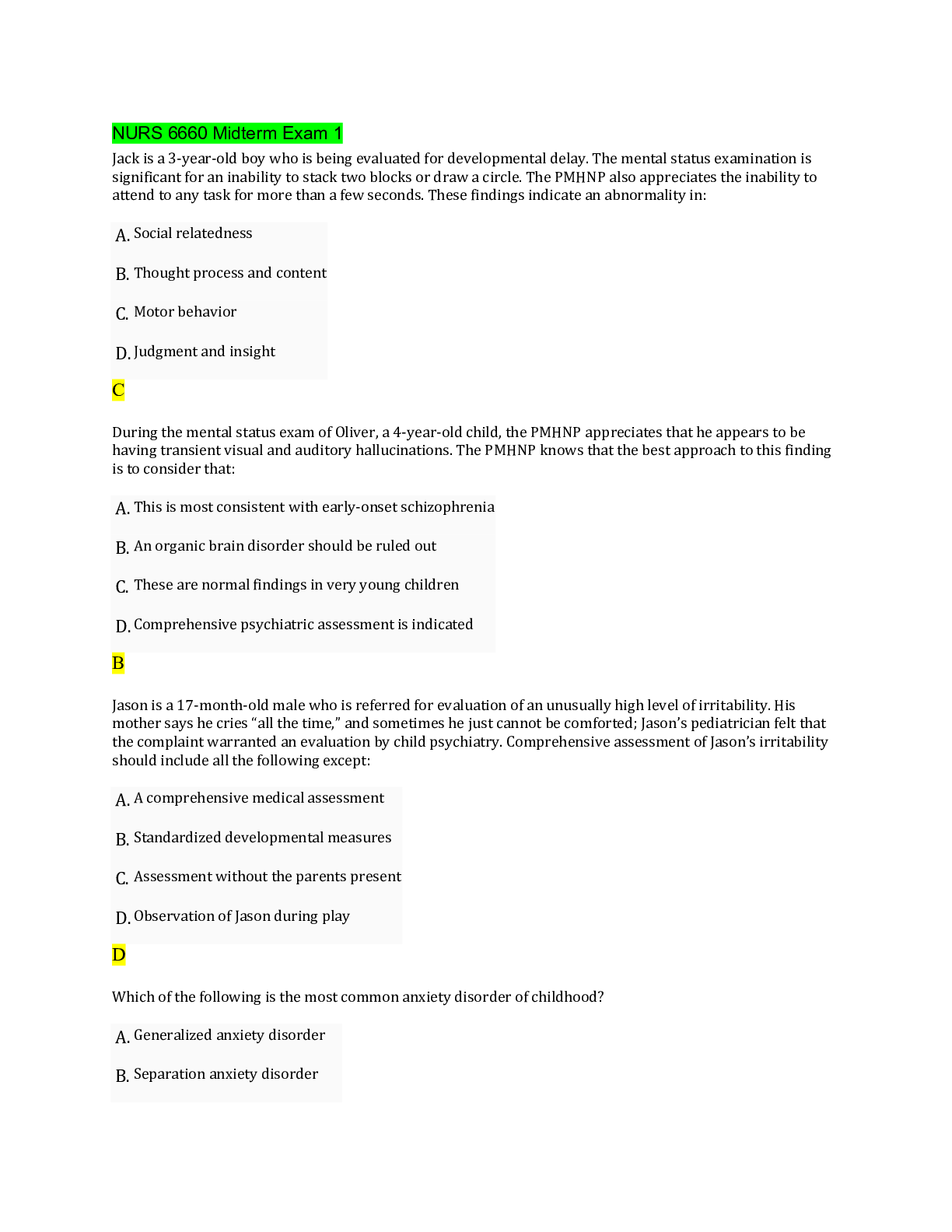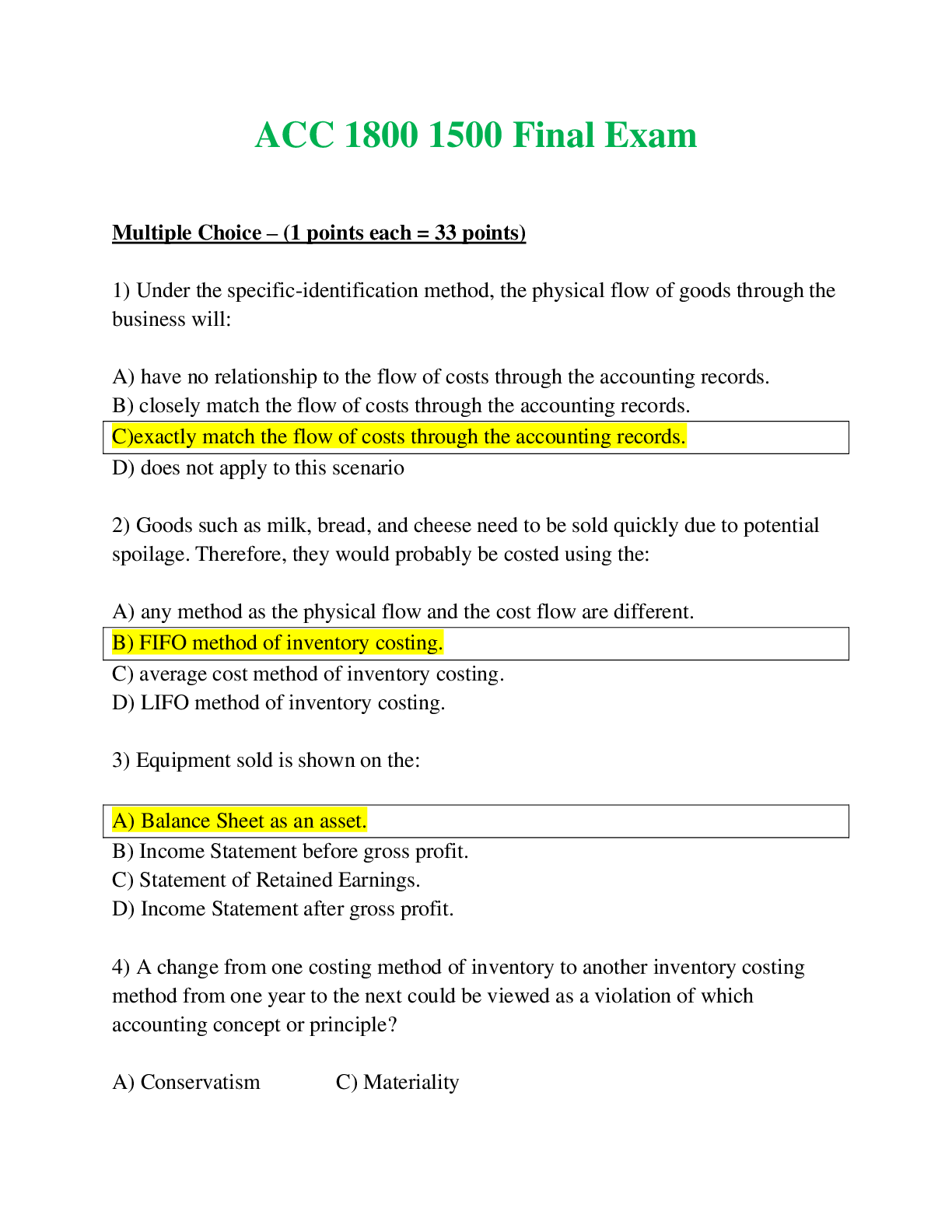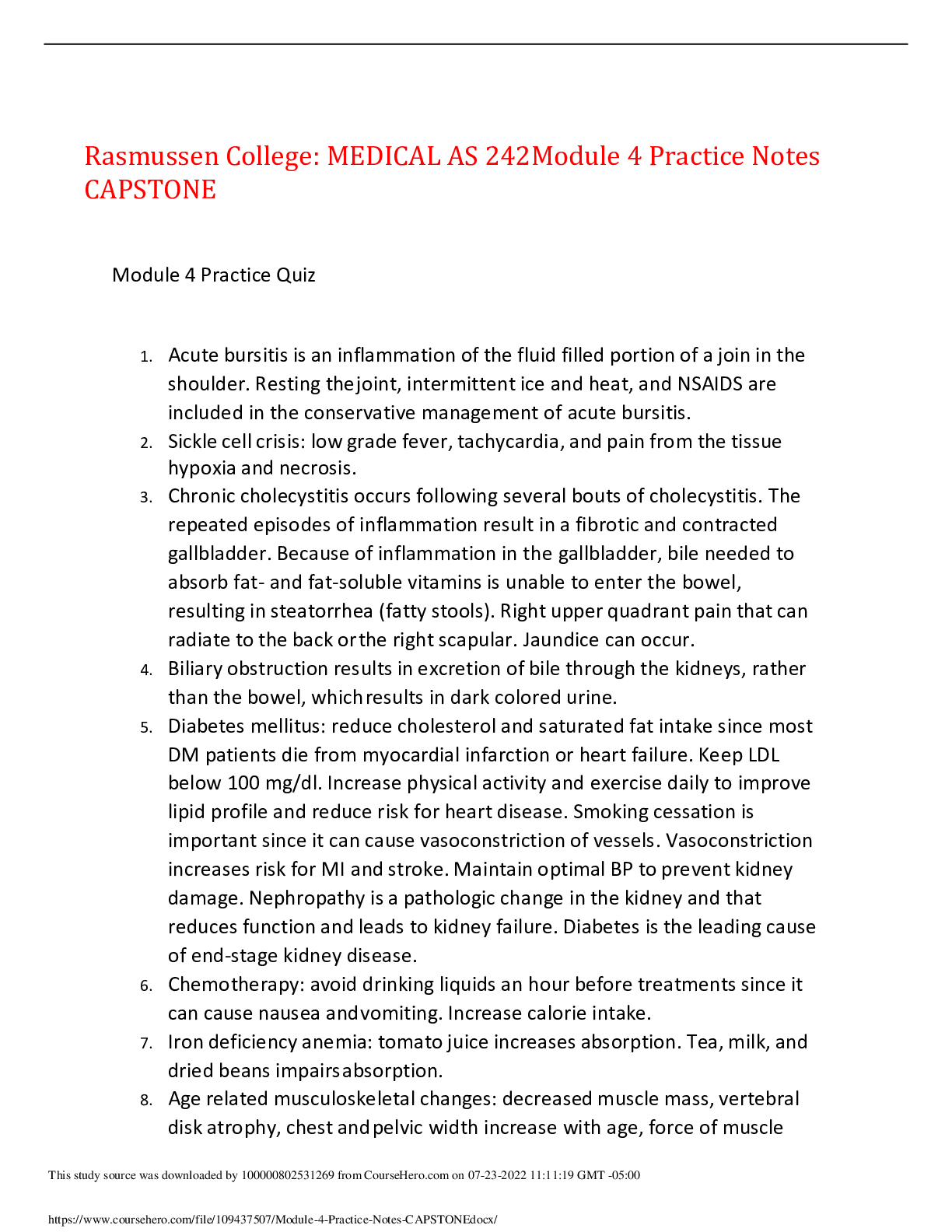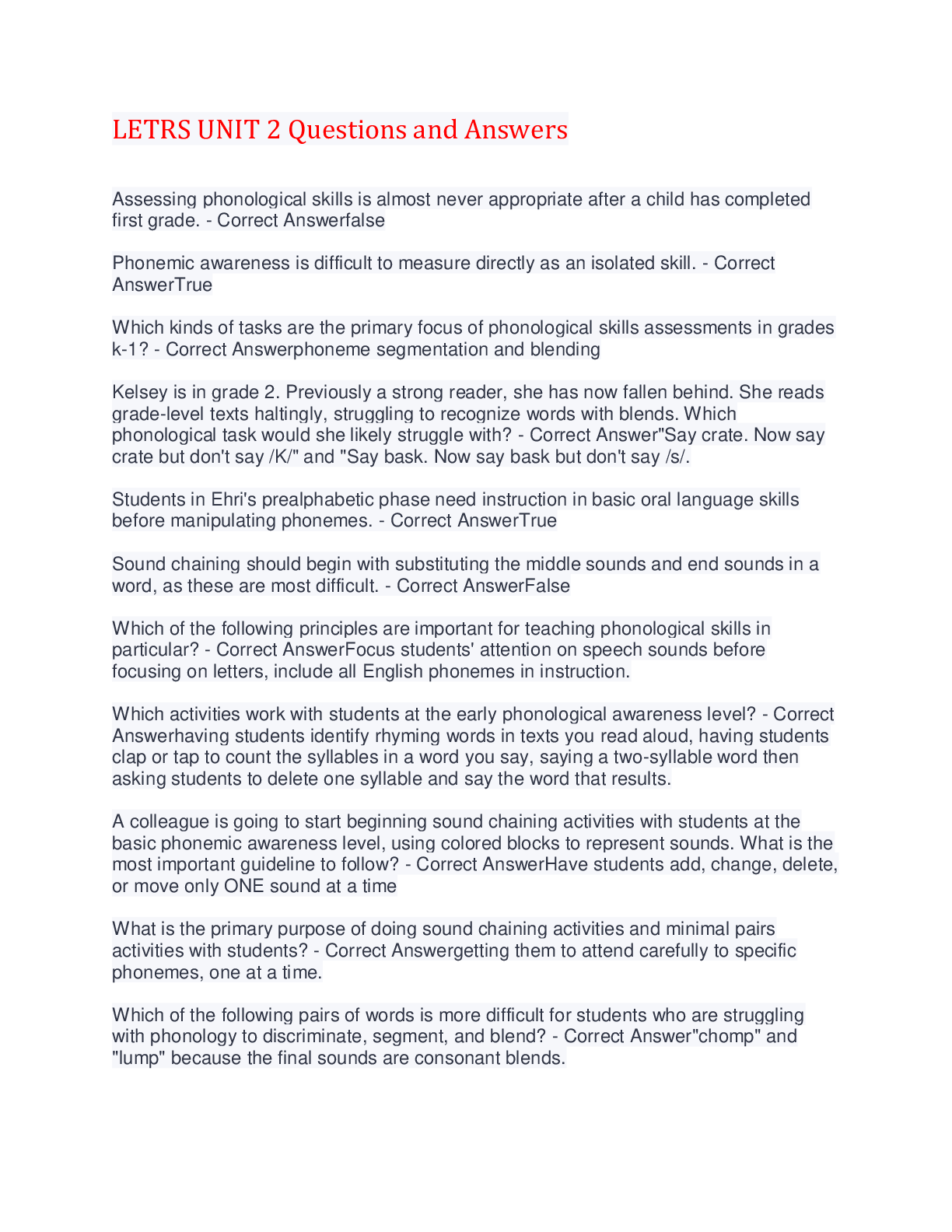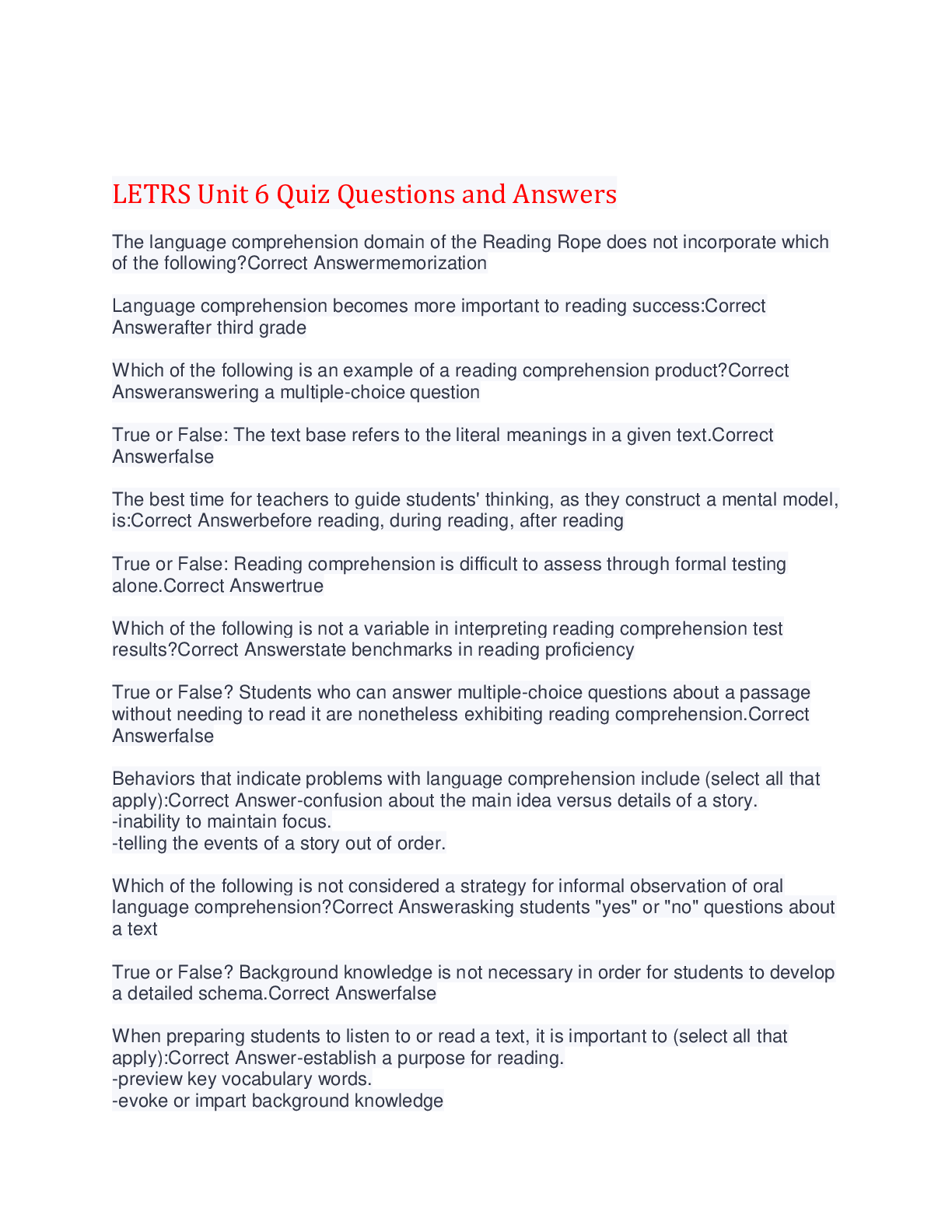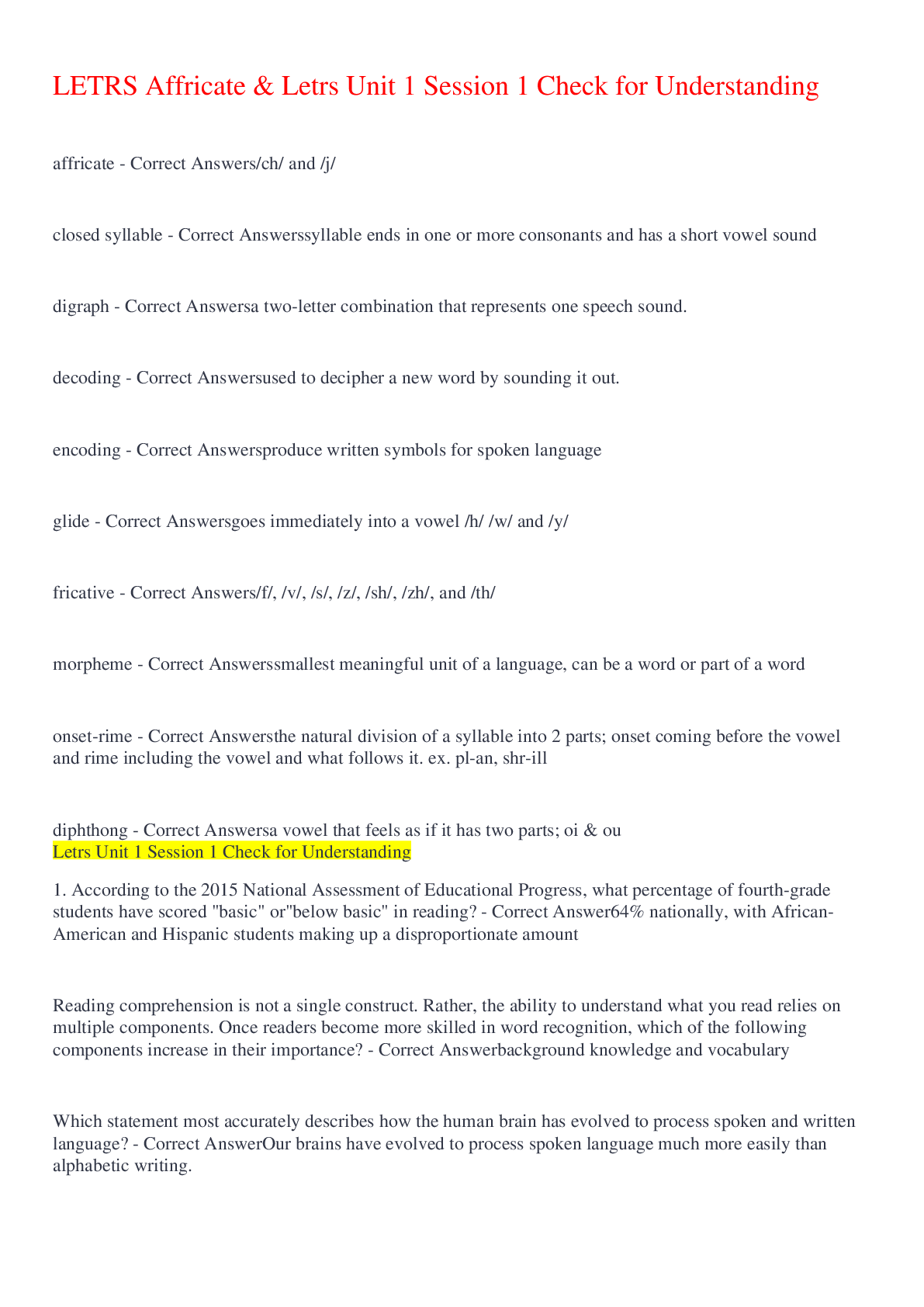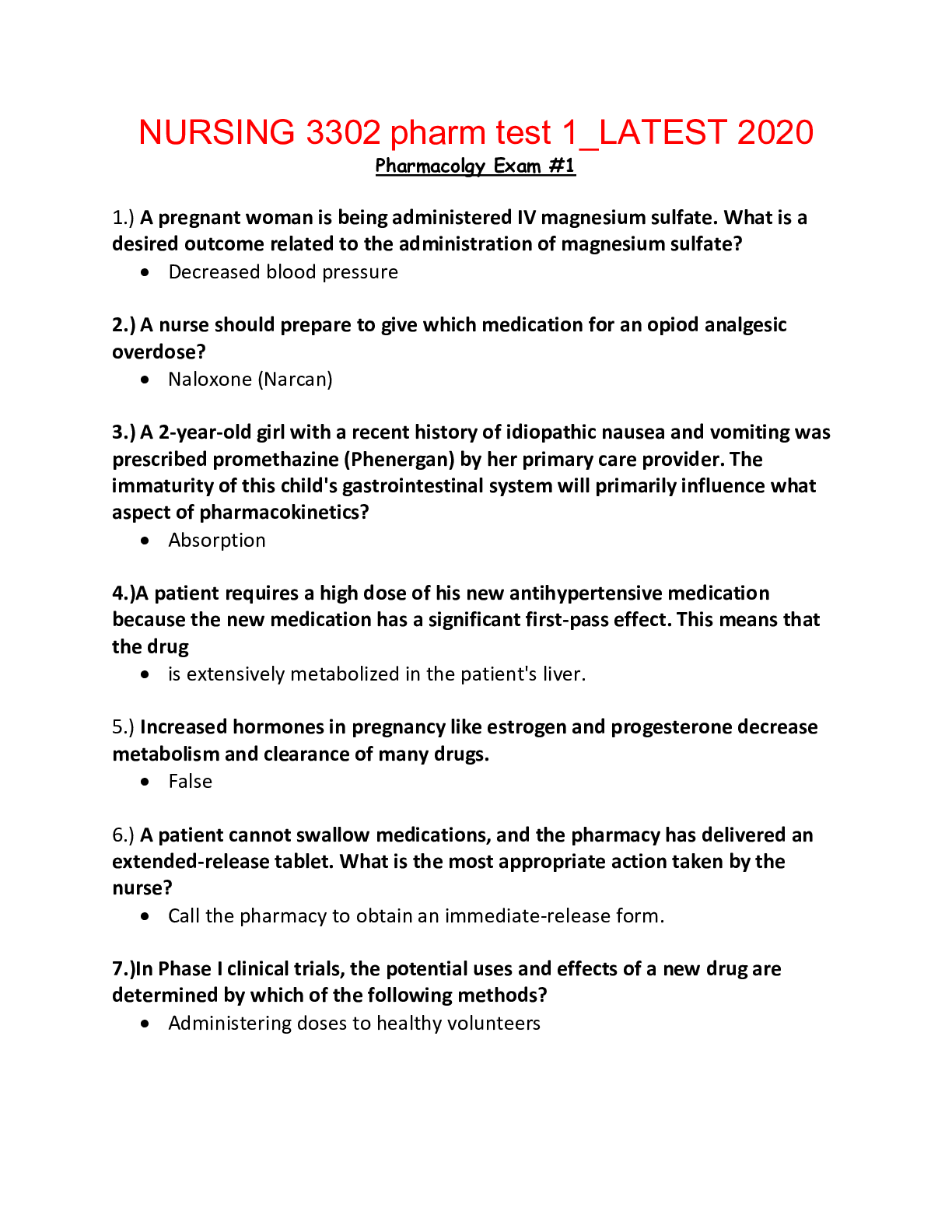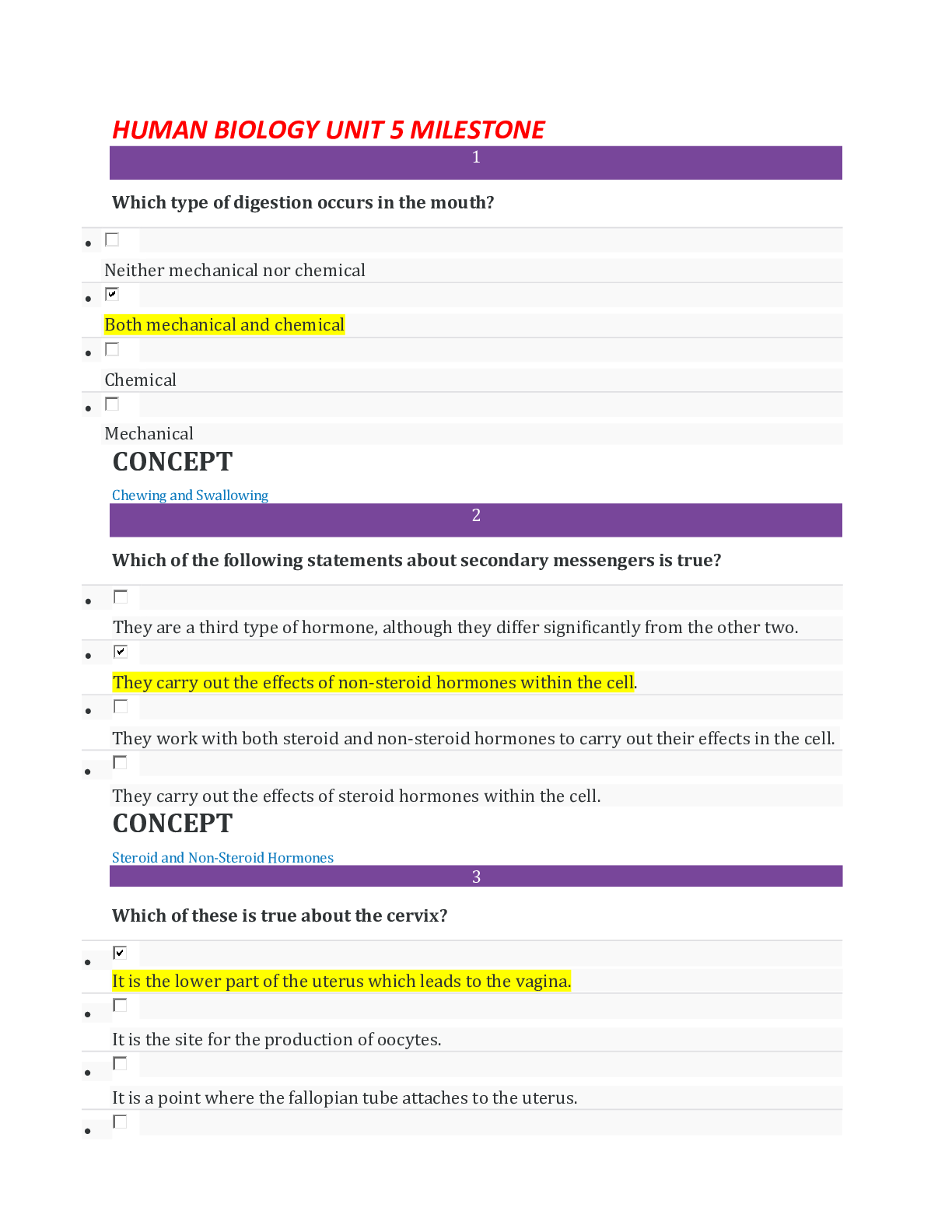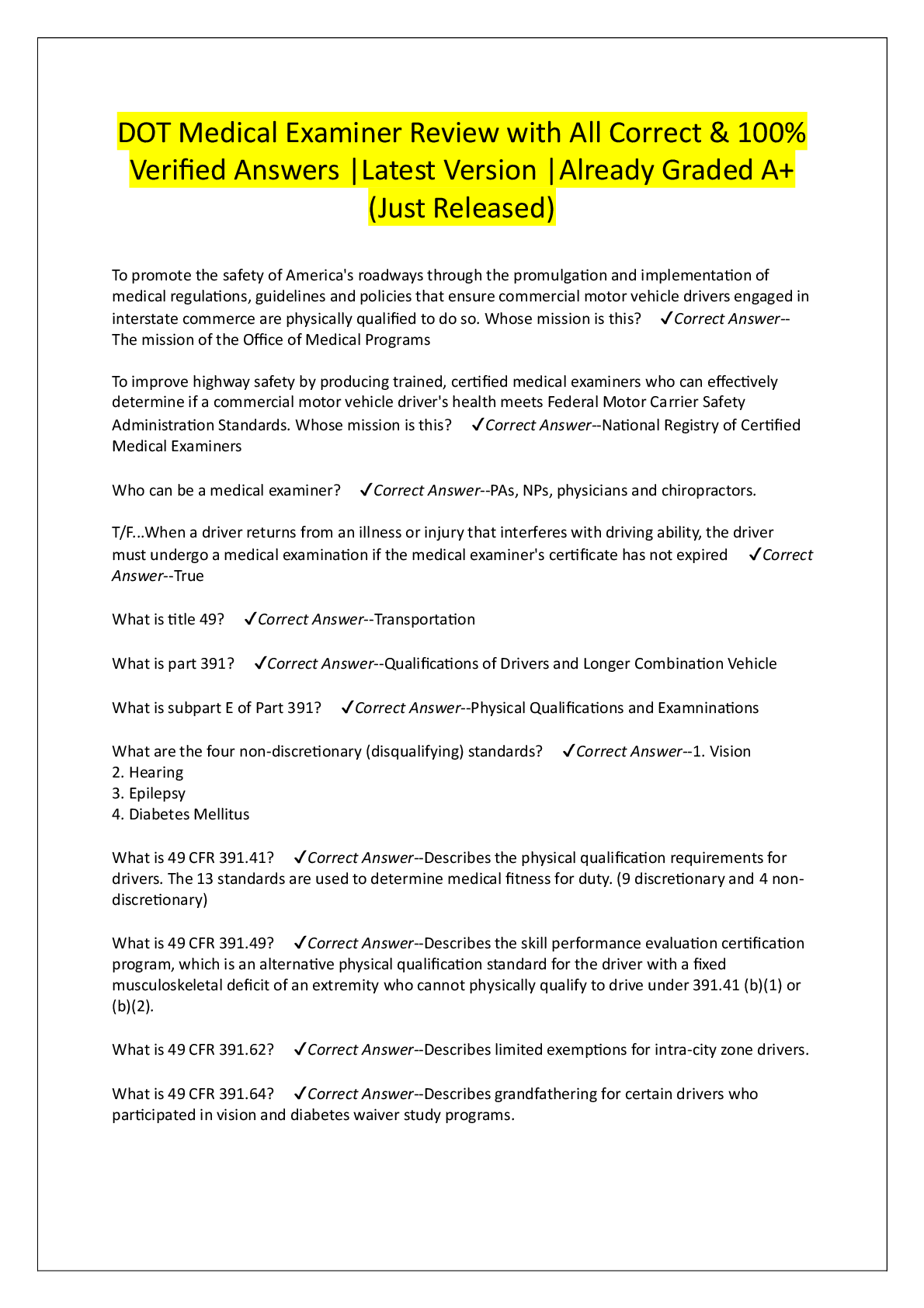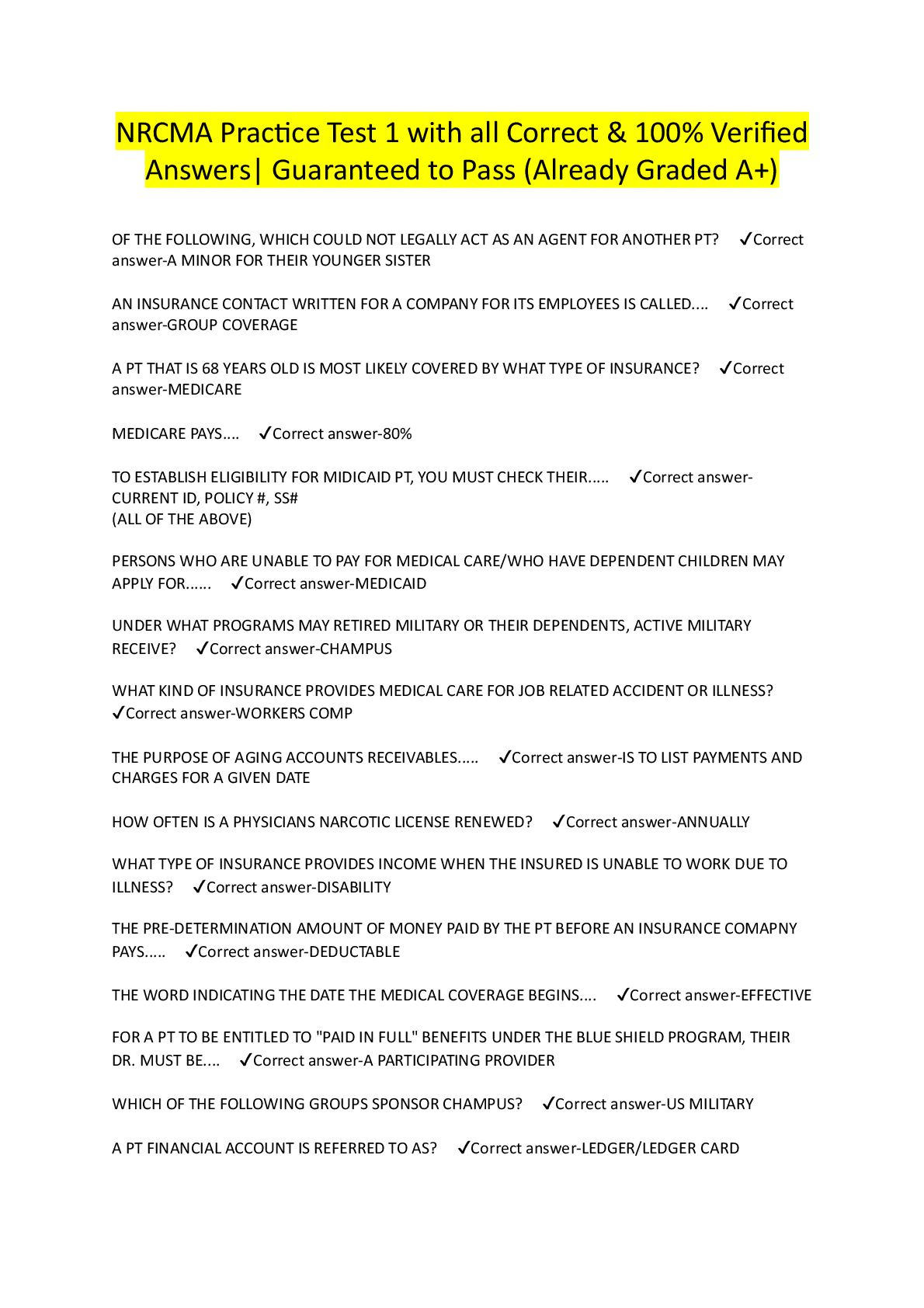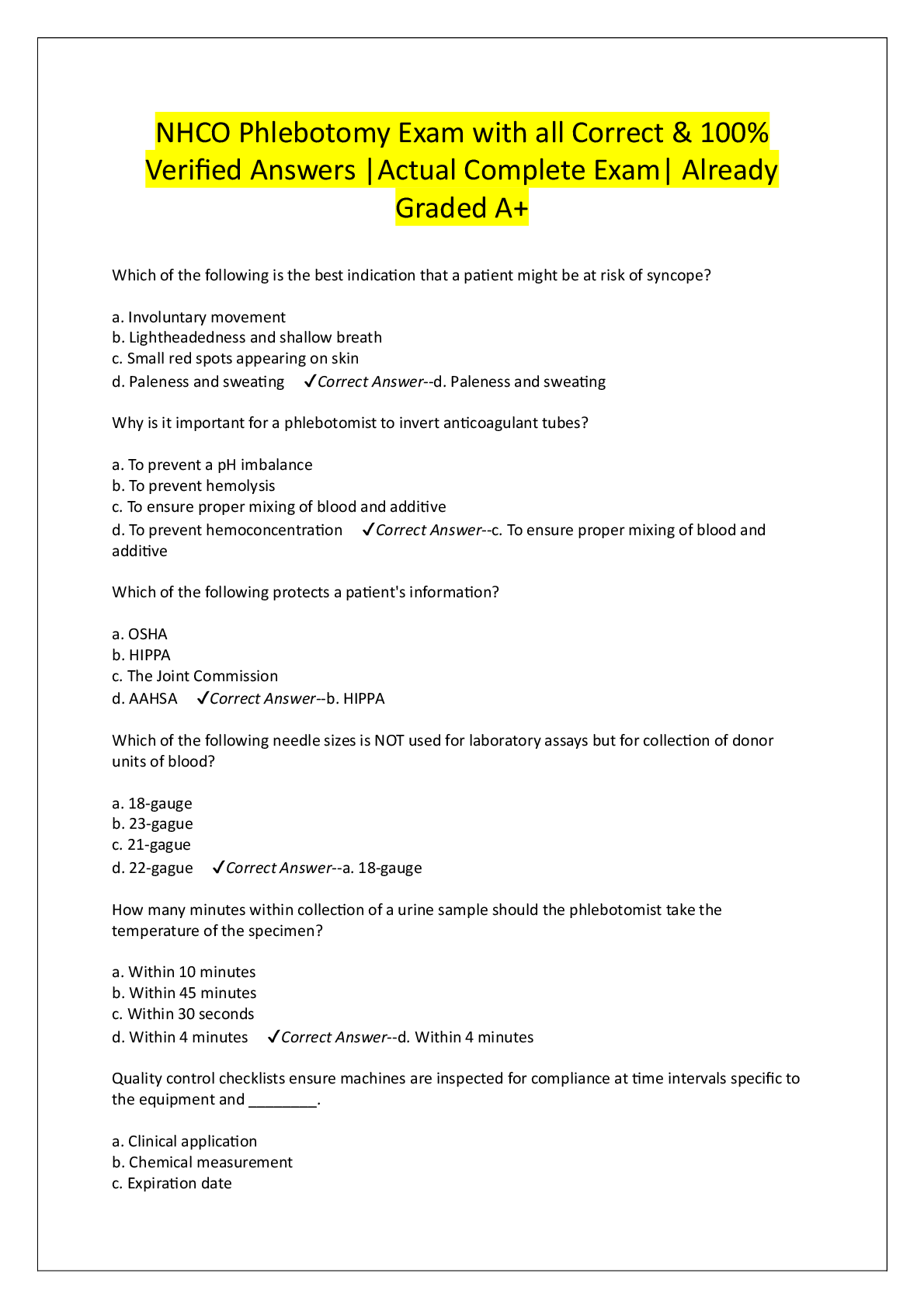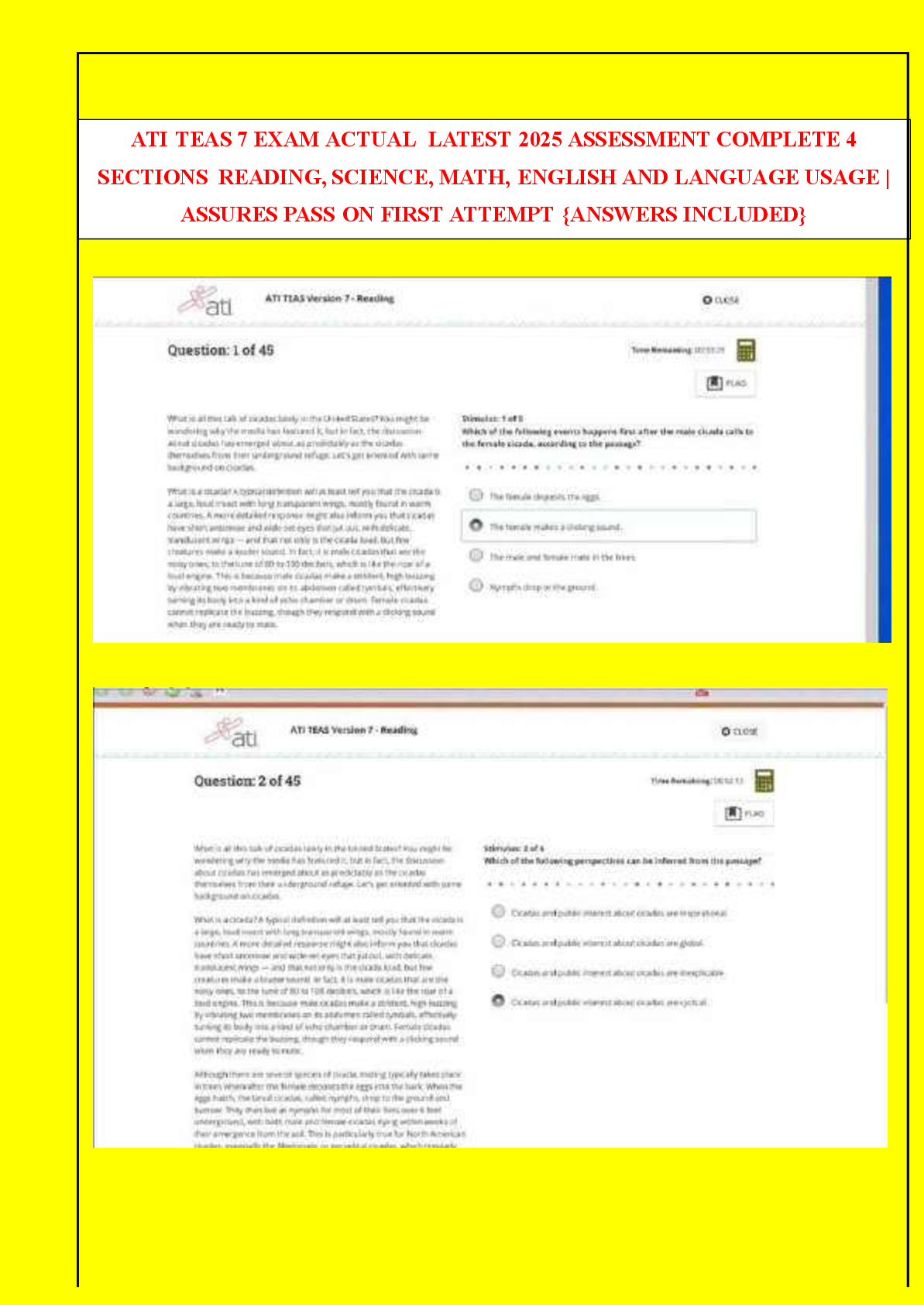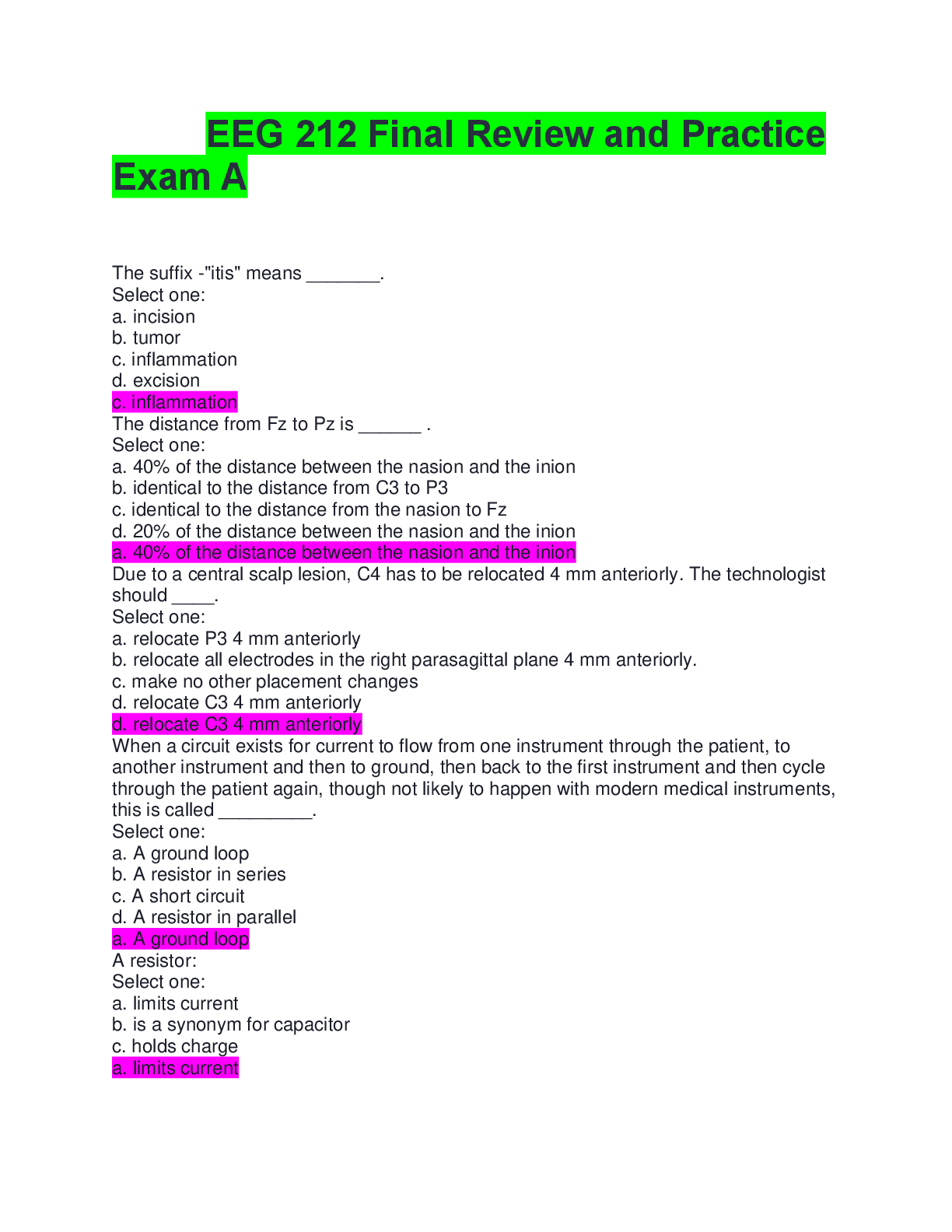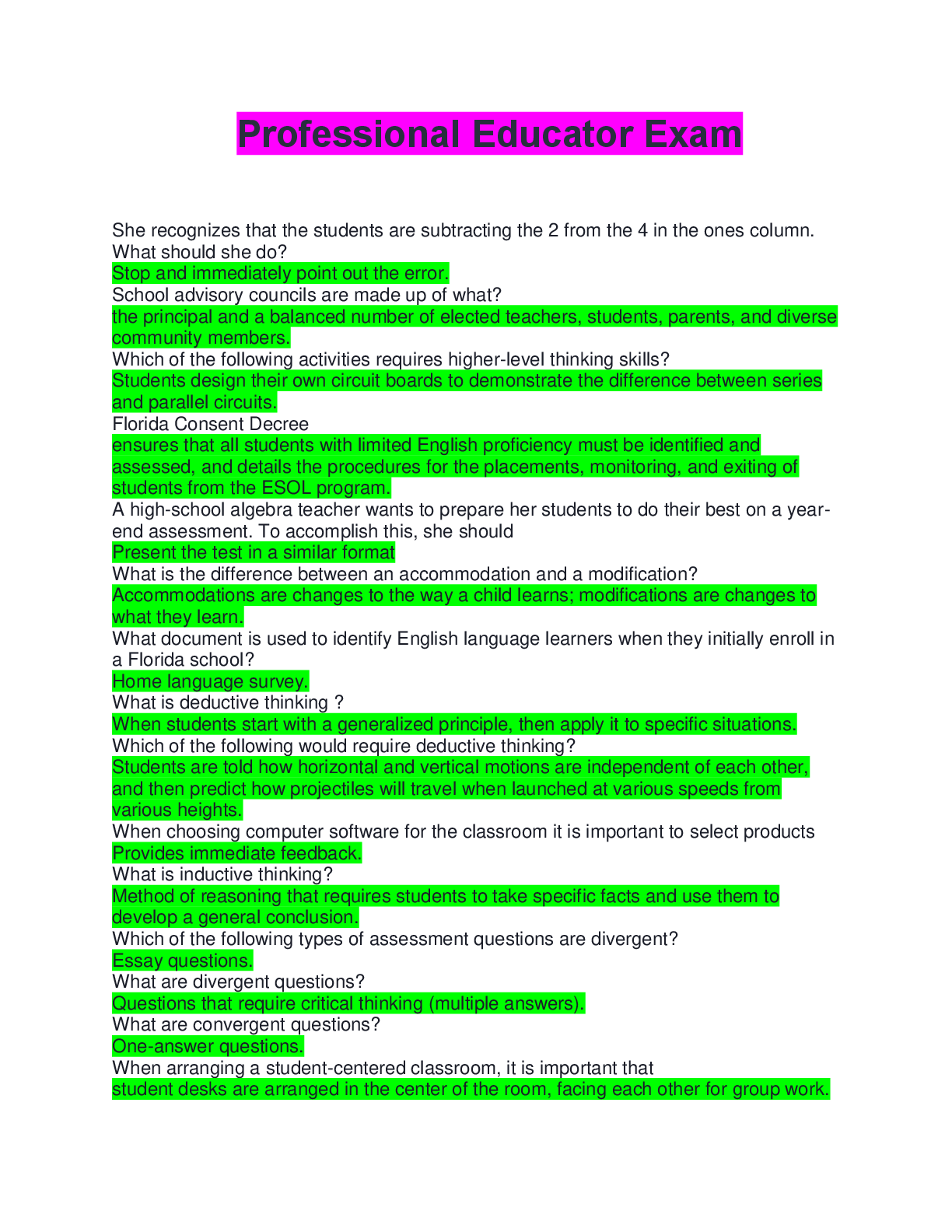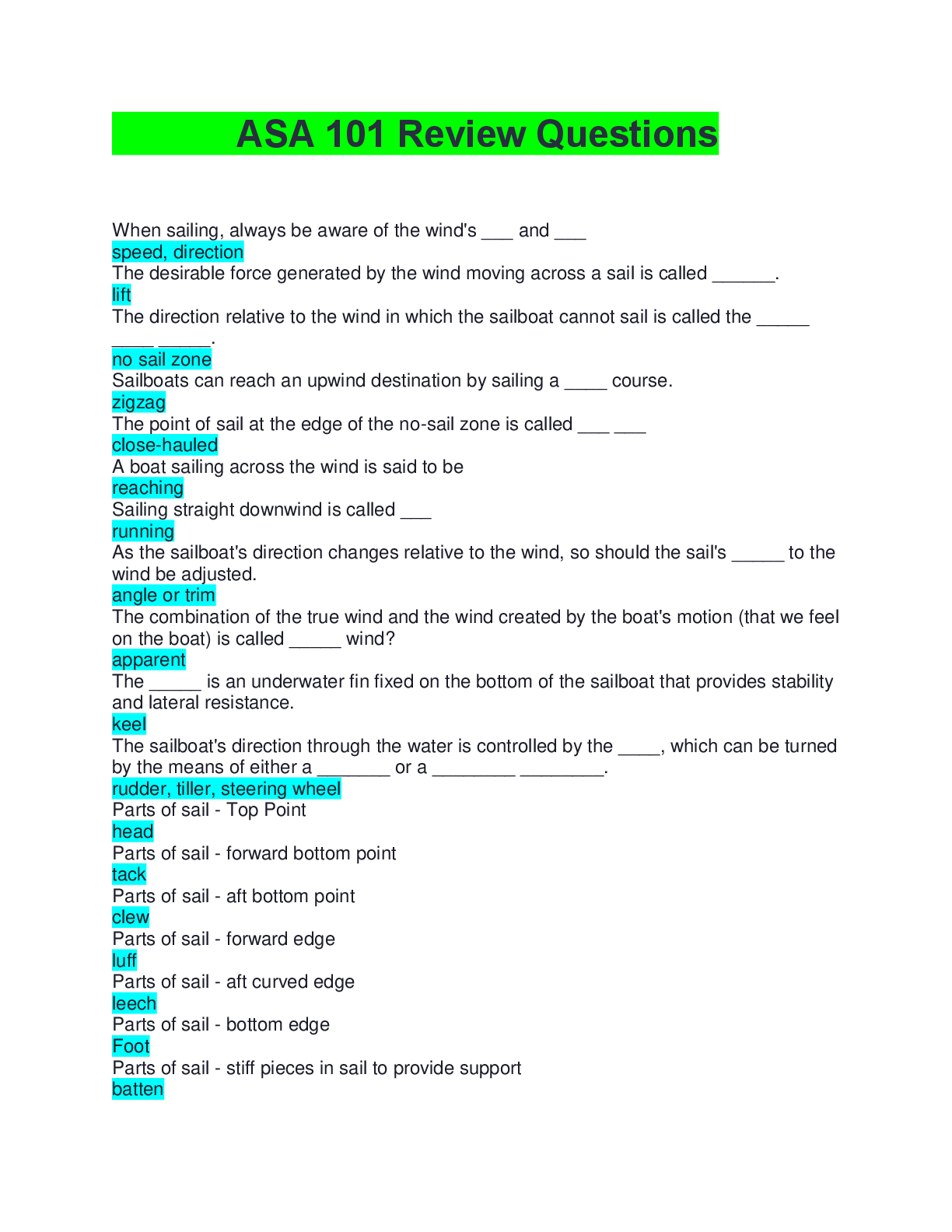*NURSING > EXAM > Applied Behavior Analysis 6225 Exam 113 Questions with Verified Answers,100% CORRECT (All)
Applied Behavior Analysis 6225 Exam 113 Questions with Verified Answers,100% CORRECT
Document Content and Description Below
Applied Behavior Analysis 6225 Exam 113 Questions with Verified Answers Frequency - CORRECT ANSWER Counting how often a specific behavior occurs Rate - CORRECT ANSWER Number of responses divided ... by the standard time period Duration - CORRECT ANSWER Total time elapsed between the start of the behavior and its completion Duration - CORRECT ANSWER Henry engaged in a tantrum 3 times. His tantrums lasted for a total of 1.5 hours. These tantrums were over a three day weekend and he had 1 tantrum per day. Response Latency - CORRECT ANSWER Measure of elapsed time between onset of stimulus and initiation of response Latency - CORRECT ANSWER The time that elapses from the signal to begin until the response occurs. Ex. Runner after hearing starting gun, teacher responding after student raises hand. Interresponse time - CORRECT ANSWER Amount of time that elapses between two consecutive instances of a response class. Ex. Clapping hands Procedures for Measuring Behavior - CORRECT ANSWER 1. Event recording 2. Timing 3. Time sampling methods Unconditioned reinforcer - CORRECT ANSWER Present at birth A reinforcer that happens naturally without any previous training. Ex. food, air, sleep, and sex Conditioned - CORRECT ANSWER Must be learned It's paired with the unconditioned reinforcer that produces a similar change in behavior. Ex. using a jacket to keep warm Discriminative Stimulus (SD) - CORRECT ANSWER Signals the availability of reinforcement. Triggers a particular behavior Motivating Operation - CORRECT ANSWER Changes the effectiveness of a reinforcer. Alters how likely you are to respond to the SD Abolishing Operation (AO) - CORRECT ANSWER Two effects: Decreases the value of a stimulus as a reinforcer and Does not evoke behavior that has gotten that stimulus in the past. Satiation Ex. Ate at buffet- decreases value of food Slept in all morning- decreases the value of sleep Establishing Operation (EO) - CORRECT ANSWER Two effects: Increases the value of a stimulus as a reinforcer and Evokes behavior that has gained that reinforcer in the past. Deprivation-Hungry= no food. Increases the value of food Motivating Operation (MO) - CORRECT ANSWER Two effects: Value Altering- Affect how much you want something. Behavior Altering- Affect what you will do to get it- behavior altering effect three-term contingency - CORRECT ANSWER The continued study of motivating operations is most important to understanding in what field of applied behavior analysis Conditioned reinforcer - CORRECT ANSWER Are established based on a history of pairing with established reinforcers Temporal order of 4 term contingency of pos. reinforcement - CORRECT ANSWER Establishing operation to discriminative stimulus to response to reinforcing stimulus Behavior analysts reinforce - CORRECT ANSWER behavior Reinforcer - CORRECT ANSWER The stimulus change responsible for the increase in responding Discriminative stimulus - CORRECT ANSWER An antecedent stimulus that evokes behavior because it has been correlated with the availability of reinforcement Generalized Conditioned reinforcer - CORRECT ANSWER A conditioned reinforcer that does not depend on a current establishing operation for any particular form of reinforcement for its effectiveness Escape;avoidance - CORRECT ANSWER Removal and reduction of ongoing stimulation typically produce behavior that is called __________ whereas postponement and prevention of stimulus presentation produce behavior that is called ____________. Negative reinforcement the reinforcer is the - CORRECT ANSWER Tangible, aversive stimulus, termination of the aversive, and termination of the establishing operation Positive Punishment - CORRECT ANSWER Delivery of a stimulus after a behavior that decreases the occurrence of the behavior According to Sidman (1993) - CORRECT ANSWER Ineffective teaching produces and exacerbates problem behavior Positive punishment - CORRECT ANSWER Has occurred when the frequency of responding has been decreased by the presentation of a stimulus. Three levels of understanding scientific investigations - CORRECT ANSWER Prediction, Description and Control Scientific "attitudes" as described by Skinner are - CORRECT ANSWER Experimentation, Philosophic Doubt, and Parsimony Respondent behavior - CORRECT ANSWER Behavior that is elicited by antecedent stimuli Reflex includes - CORRECT ANSWER An eliciting stimulus and the behavior it produces reflexive conditioned motivating operation (CMO-R) - CORRECT ANSWER A stimulus that acquires MO effectiveness by preceding some form of worsening or improvement. It is exemplified by the warning stimulus in a typical escape-avoidance procedure, which establishes its own offset as reinforcement and evokes all behavior that has accomplished that offset. transitive conditioned motivating operation (CMO-T) - CORRECT ANSWER This type of motivating operation makes something else effective as a reinforcer behavior of it's relation or association with an unconditioned reinforcer. Also has implications for the training of language in individuals with little or no speech. surrogate conditioned motivating operation (CMO-S) - CORRECT ANSWER A stimulus that accomplishes what the MO with which it was paired accomplishes (i.e. acts as a substitute for the MO). Ex. seeing a restaurant after dinner and wanting to eat again or feeling the urge to urinate after seeing the sign for the restroom. stimulus equivalence - CORRECT ANSWER The emergence of accurate responding to untrained and nonreinforced stimulus-stimulus relations following the reinforcement of responses to some stimulus-stimulus relations. A positive demonstration of the reflexivity, symmetry, and transitivity is necessary to meet the definition of equivalence. stimulus salience - CORRECT ANSWER the physical properties of the stimulus, such as color, contrast, or movement stimulus control - CORRECT ANSWER the ability of a stimulus to encourage some responses and discourage others stimulus generalization - CORRECT ANSWER learning that occurs when stimuli that are similar but not identical to the conditioned stimulus produce the conditioned response Magnitude - CORRECT ANSWER The force or intensity with which a response is emitted Dependent variable - CORRECT ANSWER The target behavior of a study. Behavior (bx) of measure. The intervention. Independent variable - CORRECT ANSWER The experimental factor that is manipulated; the variable whose effect is being studied. Direct, indirect - CORRECT ANSWER A ____________ measure of the actual behavior of interest will always possess more validity than a ___________ measure. Standard Celeration Chart (SCC) - CORRECT ANSWER A method for displaying data and is the only standardized form of data measurement in our science. Replication - CORRECT ANSWER Involves the repetition of experiments to determine the reliability of findings Parsimony - CORRECT ANSWER The idea that simple, logical explanations must be ruled out, experimentally or conceptually, before more complex or abstract explanations are considered Skinner's publication The Behavior of Organism - CORRECT ANSWER This formally began the experimental branch of behavior analysis Mentalism - CORRECT ANSWER This approach to understanding behavior assumes that inner causes or phenomena directly cause or at least mediate some forms of behavior, and strongly relies on hypothetical constructs or explanatory fiction Radical Behaviorism - CORRECT ANSWER This approach to underst byanding behavior attempts to explain all behavior, including private events. (thinking and feeling) Control - CORRECT ANSWER Is the highest level of scientific understanding. Respondent behavior - CORRECT ANSWER elicited, reflexes, involuntary, and unconditioned. (think not trained) Operant behavior - CORRECT ANSWER Voluntary, based on learning history emit/evoke Characteristics of Applied Behavior Analysis - CORRECT ANSWER Applied, behavioral, Analytic, Technological, Conceptually Systematic, Effective, Generality Consequences - CORRECT ANSWER Are stimulus changes after the behavior Response class - CORRECT ANSWER Are all the topographical forms of the performance that have a similar function. 4 reinforcer dimensions - CORRECT ANSWER rate, quality, delay and effort. Positive; reinforcement - CORRECT ANSWER Herrnstein found a near-perfect,____________ correlation between one unit increase in ___________with one unit increase in behavior. Matching Law - CORRECT ANSWER By applying the __________, you can utilize differential reinforcement without employing extinction on the inappropriate behavior. Variable ratio - CORRECT ANSWER Reinforcement that occurs after an average of 5 correct responses is an example of what schedule of reinforcement Variable interval - CORRECT ANSWER Reinforcement that occurs contingent on the first correct response after an average 5 minutes is an example of what schedule of reinforcement Concurrent - CORRECT ANSWER Two or more contingencies of reinforcement that operate independently and simultaneously for two or more behaviors constitute what schedule of reinforcement Multiple - CORRECT ANSWER A schedule that presents two or more basic schedules of reinforcement associated with distinct discriminative stimuli for a single behavior class in an alternating, usually random, sequence Chained - CORRECT ANSWER A schedule that presents two or more basic schedules of reinforcement associated with distinct discriminative stimuli in a predictable sequence. Mixed - CORRECT ANSWER Non-discriminative schedule presents two or more basic schedules of reinforcement for a single behavior class in an alternating, usually random, sequence intermittent reinforcement - CORRECT ANSWER Type of schedule are environmental arrangements developed in which some occurrences of a behavior will be reinforced and other occurrences of the same behavior will not be Fixed Ration (FR3) - CORRECT ANSWER The pitcher walks a baseball player every 3rd time up at bat. This is an example of what schedule of reinforcement. Generalized Conditioned Reinforcer - CORRECT ANSWER A conditioned reinforcer that does not depend on a current establishing operation for any particular form of reinforcement of its effectiveness. Positive reinforcement - CORRECT ANSWER _____________ for compliance alone does not suppress avoidance-motivated self-injury. Escape contingency - CORRECT ANSWER EO is present to the occurrence of the target behavior Avoidance contingency - CORRECT ANSWER EO is not present prior to the occurrence of the target behavior. concept - CORRECT ANSWER Defined by a set of shared features found in each example of the concept. abative effect - CORRECT ANSWER A decrease in the current frequency of behavior that has been reinforced by some stimulus. evocative effect - CORRECT ANSWER An increase in the current frequency of behavior that has been reinforced by some stimulus. Rate - CORRECT ANSWER is obtained by combining observation time with a tally of the number of occurrences of behavior. Experimental Analysis of Behavior (EAB) - CORRECT ANSWER Natural science approach for discovering orderly and reliable relations between behavior and the environment variables of which it is a function. duration - CORRECT ANSWER the amount of time from onset to the end point of a response, is the basic measure of temporal extent. It's measured in standard units of time. It is important when measuring the amount of time a person engaged in a target behavior. high rates. ex. rocking, rapid jerks of the head, hands and legs or task oriented. latency - CORRECT ANSWER is a measure of elapsed time between the onset of a stimulus and subsequent response. How much time occurs between the opportunities to emit a behavior and when the subject initiates the target behavior. trials of criterion - CORRECT ANSWER is a measure of the number of response opportunities needed to achieve a predetermined level of performance. It's reported as the number of trials required. time sampling - CORRECT ANSWER Refers to a variety of methods for observing and recording behavior during intervals or at specific moments in time. The basic procedure involves dividing the observation period into time intervals and then recording the presence or absence of behavior within or at the end of each interval. 3 forms of time sampling - CORRECT ANSWER Whole-Interval Recording Partial-Interval Recording Momentary-Time Sampling Whole Interval Recording - CORRECT ANSWER It is divided into a series of brief time intervals. (5-10 seconds) At the end of each interval, the observer records whether the target behavior occurred throughout the interval. Data collected are reported as the percentage of total intervals in which the target behavior was recorded as occurring. Partial Interval Recording - CORRECT ANSWER the observer records whether the behavior occurred at any time during the interval. If the target behavior occurred multiple times during the interval, it is still scored as occurring only once. Momentary-time sampling - CORRECT ANSWER Records whether the target behavior occurred at the moment the time interval ends. This is used with easily identified behaviors like engaging with a task or activity. play check - CORRECT ANSWER Uses head counts to measure group behavior. Observes a group of students at the end of each time interval, counts the number of students engaged in the targeted activity and records the rally with the total number of students in the group. measurement by permanent product - CORRECT ANSWER Measuring behavior after it has occurred by observing the effects the behavior produced. A change in the environment produced by a behavior that lasts long enough for measurement to take place. It refers to the time of measurement by which direct measurement - CORRECT ANSWER Occurs when the behavior measured is exactly the same as the behavior that is the focus of the investigation or behavior change program. observer reactivity - CORRECT ANSWER Measurement error resulting from an observer's awareness that others are evaluating the data they reports. observer drift - CORRECT ANSWER Unintended changes in the way an observer uses a measurement system over the course of investigation- can be minimized by booster training sessions and feedback on the accuracy and reliability of measurement. Unconditioned motivating operation (UMO) - CORRECT ANSWER are the MOs that one naturally has acquired without being taught a value to them. These are unlearned states of motivating Operations and include states such as being tired, hungry, thirsty and wanting of activity. Examples of UMO for humans - CORRECT ANSWER deprivation, satiation, UMOs relevant sexual reinforcement, temperature changes, and painful stimulation Premack Principle - CORRECT ANSWER Making the opportunity to engage ina high rate behavior, contingent upon the occurrence of a low rate behavior, will function as reinforcement for the low-frequency behavior. Event Recording - CORRECT ANSWER Measurement procedure for obtaining a tally or count of the number of times a behavior occurs. IOA - CORRECT ANSWER indicates the percentage of agreement between two or more observer's recording the same event Total count IOA - CORRECT ANSWER Simply denotes the percentage of agreement between two observer's frequency/ event Example of positive reinforcement - CORRECT ANSWER A mother gives her son praise (reinforcing stimulus) for doing homework (behavior) stimulus generalization - CORRECT ANSWER Refers to the extent to which stimuli other than the Sd acquire stimulus control over the behavior. Stimuli sharing similar physical properties with the Sd are most likely to acquire evocative function. discriminative stimulus - CORRECT ANSWER Behavior that occured more often in the presence of a stimulus. stimulus delta - CORRECT ANSWER Absence of a stimulus. Premack Principle - CORRECT ANSWER Arranging high- frequency activities to follow low - frequency activities is an application of difference between avoidance and escape - CORRECT ANSWER In the escape the EO is present to the occurrence of the target behavior, while in an avoidance contingency, the EO is not present prior to the occurrence of the target behavior. Matching Law - CORRECT ANSWER As reinforcer deliveries increase along the x- axis proportional increases in behavior are depicted along y-axis. By applying matching law - CORRECT ANSWER You can utilize differential reinforcement without employing extinction on the inappropriate behavior. positive punishment - CORRECT ANSWER delivery of a stimulus after a behavior that decreases the occurrence of the behavior. Arbitrary stimulus class - CORRECT ANSWER Evoke the same response, but they do not share a common stimulus feature. Ex. 50%, 1/2, .5. different physical forms will evoke the same response, half. prompts - CORRECT ANSWER Are supplementary antecedent stimuli used to occasion a correct response in the presence of the natural Sd that will eventually control the behavior. concept formation - CORRECT ANSWER A complex example of stimulus control that requires stimulus generalization within a class of stimuli and discrimination between classes of stimuli. feature stimulus class - CORRECT ANSWER Stimuli that share common physical forms or structures (e. g., made from wood, four legs, round, blue), or common relative relationship ( bigger than, hotter than, higher than, next to). automatic reinforcement - CORRECT ANSWER involved the reinforcement occurring independent of another person delivering it. determinism - CORRECT ANSWER the assumption that the universe is lawful and orderly place in which phenomena occur as a result of other events methodological behaviorism - CORRECT ANSWER the philosophical position that considers behavior events that cannot be publicly observed to be outside the realm of science Radical behaviorism - CORRECT ANSWER Attempts to explain all behavior, including private events such as thinking and feeling. S-R psychology - CORRECT ANSWER Direct observation of the relationships between environmental stimuli (S) and the response (R) they evoke. Empiricism - CORRECT ANSWER The objective observation of the phenomena of interest topography - CORRECT ANSWER The physical form or shape of a behavior. [Show More]
Last updated: 2 years ago
Preview 1 out of 13 pages

Buy this document to get the full access instantly
Instant Download Access after purchase
Buy NowInstant download
We Accept:

Reviews( 0 )
$9.00
Can't find what you want? Try our AI powered Search
Document information
Connected school, study & course
About the document
Uploaded On
Dec 17, 2023
Number of pages
13
Written in
All
Additional information
This document has been written for:
Uploaded
Dec 17, 2023
Downloads
0
Views
82



